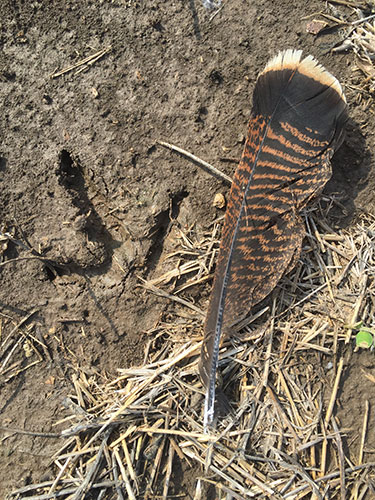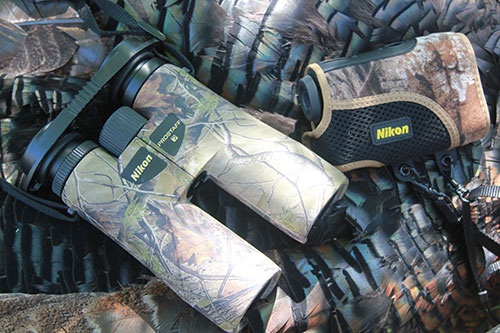Do you believe “the birds are either there or they aren’t— but they usually are, so why bother scouting?” Not a good plan.
Text and photos by Bob Robb

Fresh turkey sign – tracks, feathers and droppings – are what I’m looking for, especially near roost trees and on field edges where the birds might be feeding. Photo credit Bob Robb
Why is it that big-game hunters are fanatical scouters, but many turkey hunters can’t seem to find the time for it? If you hunt and control the access to private land that might be fine, but if you’re a ham-and-egg public-land gobbler getter, and/or hunt vast acreage out West, you can bet the farm that others are out looking for birds long before the season opens.
For me, it’s a lot like when I scout for deer or elk. I’m looking for birds anywhere and everywhere, but primarily looking for birds off the beaten path. After opening weekend, the easy birds have either been scarified or killed. The ones that survived will be extra tough to trick into shotgun or bow range. I want to have as many aces in the hole as possible.
Here’s my top 10 list of how to scout smart to have the best turkey season of your life.
10) Get Permission Early
One of the best ways to do your preseason scouting is to ask for, and then lock up, permission to access private land early. This also helps gather information from landowners about the turkeys on the property, saving you lots of time. Plus, once you secure permission, there’s a chance that the landowners might turn others down. And even if a landowner turns you down, if you’re friendly and polite they might say yes the next time. Even better — if there’s adjacent public land, knowledge of turkey numbers and habits on private ground can help you plan your public-land hunts. Just sayin’ …
9) Practice Calling
One truth: you can be a super deer hunter without ever making a sound, but if you want to consistently kill gobblers, you have to be a decent caller. That takes practice. It’s never too early to work on your calling skills. I drive my wife nuts as I work some on new diaphragm calls while sitting at my desk, and I practice with them while driving around town, too. Way more fun than listening to talk radio.
8) Scout From Home
It has never been easier or more productive to accomplish a good portion of your scouting from the comfort of the living room. Using smartphone apps like HuntStand and HuntStand Pro, OnX Hunt, BaseMap, Google Earth and others, as well as topographic maps, you can learn a lot about a property before ever setting foot there.
With HuntStand Pro, you can access satellite images that have been updated monthly, giving you a real-time vision of the area, as well as the ability to go back in time, month by month, for several years, so that changes and trends can be seen. It’s the only app in the world currently offering this feature.
You can also use many state game departments’ websites to learn all you can about turkey hunting in each state, harvest statistics, population dynamics, etc. Many states also offer walk-in hunt programs that allow the unattached hunter to access private lands. They are definitely worth investigating.
7) Timing is Everything
Scout specifically for opening day, especially if you’re a public-land hunter. While late-fall and winter observations of turkeys are cool, winter flocks alter feeding patterns as warmer weather sprouts fresh food sources. To nail down where birds will be, serious scouting doesn’t need to occur any earlier than two to three weeks before opening day. But earlier scouting trips will help you get the lay of the land, and also help formulate a plan to hunt areas that are not quite as easy to access as close-to-the-road spots that will be overrun with other hunters on opening weekend. Once the season is open, scouting morphs into run-and-gun hunting.

In many areas of the country, an important part of scouting is glassing, so be sure to bring along a good 8X or 10X bino. Photo credit Bob Robb
6) Stop and Listen
A great way to scout is to access a high point in an area that you want to check out well before first light, and again an hour or so before sundown, then just sit and be quiet. Pick a quiet, calm morning or evening (first and last light are usually the calmest parts of the day, even on days with strong winds) and listen for gobbling on the roost, and for turkeys as they fly down from and up to the roost. Use binoculars and spotting scopes to glass for birds in the trees.
5) Ground Check
If turkeys aren’t gobbling or visible, don’t despair — simply search for other clues. Tracks, scratching, droppings and strut marks can reveal travel, loafing or feeding areas. Droppings and feathers — especially primary wing feathers — near suitable trees might reveal roosts. Dusting areas can be golden, as turkeys visit these frequently during the day. As you find sign, look around for potential set-up spots or ambush sites. One caveat: do your walking during midday hours so you won’t inadvertently spook birds as they move about close to their roosting areas.

Of course you want to see gobblers when scouting if you can, but often, it is just the sign of a flock that will put you into position. Photo credit Bob Robb
Don’t forget about glassing. In areas where you can access high points and glass lots of country, do so. I can’t tell you how many birds I’ve glassed up in open country at long distances, then planned a way to sneak into position later on.
4) Map Check
Simply finding tracks, feathers and droppings is just the beginning. Unless they’re in a primary roosting area you shouldn’t get overly excited just yet. Now grab your topo map and see if you can figure out where the birds might be heading and the likely route they’ll be taking. Finding travel routes between bedding areas (roost trees) and food sources can be dynamite. Sounds familiar, doesn’t it, deer hunters?
3) Smile For the Camera
Speaking of deer hunting, trail cameras are for much more than big-game hunting, you know. Once you find sign or observe turkeys on the move, cameras can pinpoint where they are hanging out and what routes they use for travel. I’ve used cameras to cover potential roosts, travel corridors (including dirt and two-track roads, and old logging trails), fields and meadows where birds might be feeding, hardwood ridges and water sources. Multiple cameras allow you to cover lots of ground at one time. Photographic evidence of where birds like to enter and exit a big meadow or field during midday can tell you where you might want to set up an ambush and wait them out on slow or quiet days.
2) Shut the Heck Up!
I know, I know. You’ve worn those new diaphragms out practicing, and you need to see how that Old Faithful box call sounds. Show some restraint when scouting and limit the use of your turkey calls, instead just focusing on a locator-type call (crow, coyote, etc.) If you can elicit a shock gobble, cool beans. While you shouldn’t be afraid to use your turkey calls, don’t educate birds now by scaring them with too much yelping. It’s best to be a stealth bomber and disturb your hunting area as little as possible while you scout.

Bob and Cheryl Robb with a beautiful pair of Merriam’s gobblers taken in northeast Wyoming. The birds were located before opening day, and rode in the truck on the opener. Photo credit Bob Robb
1) Keep a Logbook
Keep a list of places where you find turkeys year after year. Make a quick stop there just to be sure the turkeys are still there. It doesn’t matter whether you hear a gobbler or not, as long as you find scratchings, droppings, tracks or feathers — clues that turkeys still live there. Even if you find only the sign of hens, if hens are there, gobblers will be, too. Once you’ve verified turkeys are in your trusted spots, head off and scout new places. Because as we all know, nothing lasts forever, and good places go bad, sooner or later. The more options you have, the better.
Regardless, always remember that no matter how well you scout and prepare, turkeys have a nasty habit of throwing you curveballs. No worries, matey. Thanks to your scouting efforts, you have a plan, and the season is long. Enjoy every minute of it.
Bonus Tips
Have Plans A, B, C
As opening day approaches, take stock of all of the information you’ve gathered while scouting and plot a strategy. Identify the best spots for a fly-down hunt. Note places to intercept birds as they eat or travel. Plot out good plan B and C spots where you can cold-call or walk and call during quiet late mornings, or set ambushes along field edges or water holes. What will you do if you get to your primary spot opening morning and find another truck parked there? Or the birds don’t respond, or they get away from you? The better prepared you are the less time you’ll waste in unproductive situations.

In open country, calling and glassing is a common way to try and locate birds when scouting. Photo credit Bob Robb
Sneak Attack
As an unattached public-land hunter from way back, one thing that I learned very early on was that other hunters will piggyback on your knowledge if you carelessly allow them to. For that reason, I am very, very careful to not let anyone know where I am scouting and hunting. How do you do that? Well, you …
- Park your vehicle away from where you’re actually scouting. I might park a quarter- to half-mile from the place I really want to check out, then stay off the road as I hike over to it, just to keep others from knowing exactly where I’m looking.
- Remove obvious turkey sign. Out West, I’ve often driven dirt backroads calling and looking for turkey sign on the road itself. If I find sign — tracks, feathers, droppings — I note the location on my map, then remove the sign so others won’t see it. A whisk broom is a great tool for sweeping away tracks — both a turkey’s, and yours.
- Scout during the middle of the week whenever possible to avoid the weekend rush.
